Top 13 Splunk Alternatives in 2025: From Open Source to Enterprise Solutions
Splunk is a powerful tool for data analysis and monitoring, but its high costs and complex implementation can be challenging for many organizations.
Here are 13 proven Splunk alternatives that provide robust monitoring capabilities, comprehensive data analysis, and more cost-effective solutions for organizations of all sizes.
Splunk use cases
Splunk is a popular platform for searching, monitoring, and analyzing machine-generated data. It's widely used for a variety of purposes, including log management, security information and event management (SIEM), and business intelligence.

Splunk excels at quickly searching, analyzing, and visualizing large volumes of data. It can handle a wide range of data types, including logs, metrics, and events.
Splunk's search language, SPL (Search Processing Language), is robust and flexible. It allows you to create complex queries and build custom reports and dashboards.
Splunk offers robust security features and is often used for compliance and auditing purposes, helping organizations meet regulatory requirements.
Splunk shortcomings
Cost. Splunk can be expensive, especially as data volumes grow. Licensing costs are based on the amount of data ingested, which can be a significant expense for large organizations.
Complexity. Splunk's power is accompanied by a steep learning curve, which can make it challenging for newcomers to fully grasp the platform's capabilities and write efficient SPL queries.
Resource Intensive. Splunk can be resource-intensive, requiring dedicated hardware and personnel for effective management and maintenance.
Limited Free Tier. The free version of Splunk, known as Splunk Enterprise Free, has limitations in terms of data volume and features, which may not be sufficient for some organizations.
Cloud Integration Limitations. While Splunk offers cloud solutions, it can face challenges when integrating with modern cloud services and microservices architectures. This is particularly noticeable when working with cloud-native applications and serverless architectures.
Customization Challenges. Despite Splunk's extensive customization options, creating specialized solutions for unique business needs can be resource-intensive and may require significant development effort.
Container Environment Constraints. Working with containerized applications can present difficulties in efficient log collection and analysis, especially in dynamic environments with frequent container creation and destruction.
Feature Comparison Matrix
This matrix provides a comprehensive overview of key features and pricing across major Splunk alternatives:
| Feature | Uptrace | SkyWalking | SigNoz | Logstash | Fluentd | LogDNA | Logz.io | Graylog | Datadog | NewRelic | Dynatrace | Appdynamics | Loggly |
|---|---|---|---|---|---|---|---|---|---|---|---|---|---|
| Open Source | ✓ | ✓ | ✓ | ✓ | ✓ | ✗ | ✗ | ✓ | ✗ | ✗ | ✗ | ✗ | ✗ |
| Cloud Native | ✓ | ✓ | ✓ | ✓ | ✓ | ✓ | ✓ | ✓ | ✓ | ✓ | ✓ | ✓ | ✓ |
| APM | ✓ | ✓ | ✓ | ✗ | ✗ | ✗ | ✓ | ✗ | ✓ | ✓ | ✓ | ✓ | ✗ |
| Log Management | ✓ | ✗ | ✓ | ✓ | ✓ | ✓ | ✓ | ✓ | ✓ | ✓ | ✓ | ✓ | ✓ |
| Infrastructure Monitoring | ✓ | ✓ | ✓ | ✗ | ✗ | ✗ | ✓ | ✓ | ✓ | ✓ | ✓ | ✓ | ✗ |
| Distributed Tracing | ✓ | ✓ | ✓ | ✗ | ✗ | ✗ | ✓ | ✗ | ✓ | ✓ | ✓ | ✓ | ✗ |
| SIEM Capabilities | ✗ | ✗ | ✗ | ✗ | ✗ | ✓ | ✓ | ✓ | ✓ | ✗ | ✓ | ✗ | ✗ |
| Deployment Complexity | Medium | Medium | Low | Medium | Low | Low | Low | Medium | Low | Low | Medium | Medium | Low |
| Price Range | Free | Free | Free | Free | Free | $$ | $$ | Free/$ | $$$ | $$$ | $$$$ | $$$$ | $$ |
Price Range Legend: Free - Open source or free version available | $ - Basic pricing tier | $$ - Moderate pricing | $$$ - Enterprise pricing | $$$$ - Premium enterprise pricing
Splunk alternatives
Uptrace
Uptrace is a powerful open-source observability platform that delivers enterprise-level monitoring capabilities. The platform excels at collecting, analyzing, and visualizing data across your entire technology stack - from applications and cloud services to infrastructure components.
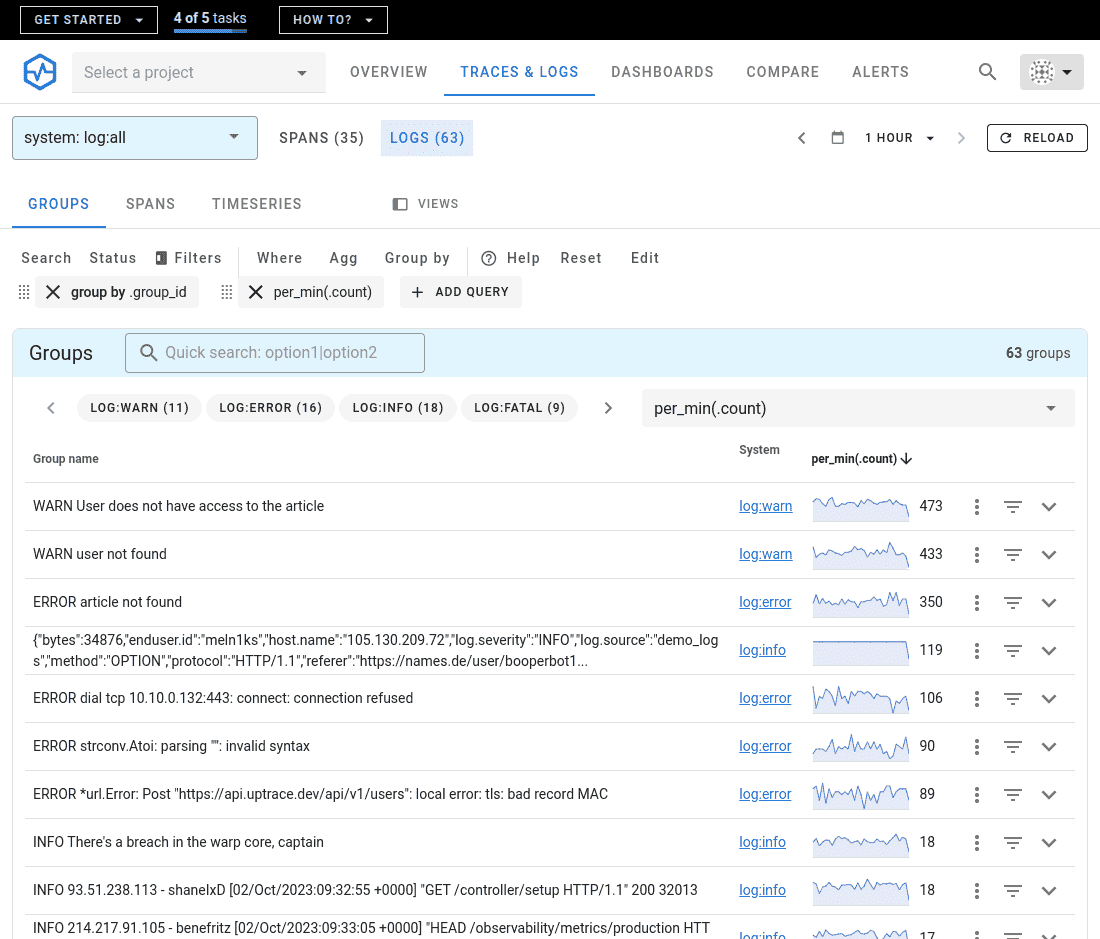
Key strengths:
- Enterprise-grade scalability with distributed architecture
- Advanced APM capabilities with real-time insights
- Rich visualization tools for metrics and traces
- Native OpenTelemetry support
- Comprehensive integration ecosystem
- Active and growing community
Technical capabilities:
- Flexible deployment options with Docker and Kubernetes
- Built-in support for modern technology stacks
- Powerful dashboard customization
- Advanced alerting system
- High-performance data processing
Cost benefits:
- Free open-source solution without data limits
- No vendor lock-in
- Infrastructure costs only
- Optional commercial support if needed
Experience Uptrace firsthand through the cloud demo (no login required) or deploy locally using Docker. Full source code is available on GitHub.
Skywalking
Apache Skywalking is an open-source APM solution that specializes in distributed tracing and performance monitoring. The platform particularly excels in microservices architectures and cloud-native applications.
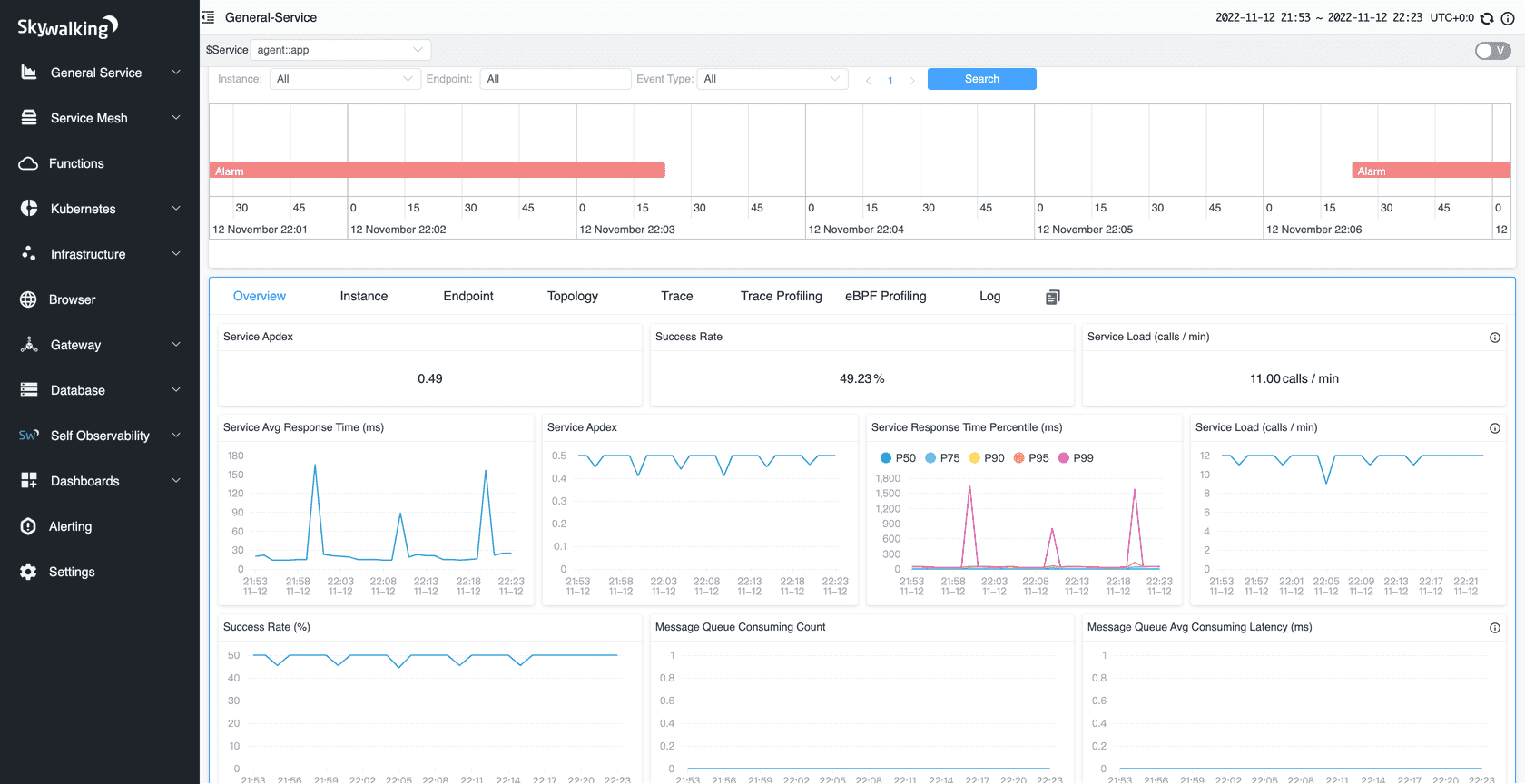
Key strengths:
- Full-stack monitoring and tracing capabilities
- Purpose-built for microservices environments
- Service mesh monitoring support
- AI-powered analysis capabilities
- Strong Apache community backing
Technical considerations:
- Steep learning curve for initial setup
- Limited functionality outside of APM domain
- Requires significant resources for large-scale deployments
- Complex configuration for advanced use cases
- Not as feature-rich in security monitoring
Cost factors:
- Free open-source solution
- No licensing costs
- Self-hosted deployment expenses only
- Community-driven support included
Experience Skywalking firsthand through the official demo (login/password: 'skywalking') to evaluate if it meets your APM-specific needs.
SigNoz
SigNoz is a newer entrant in the observability space, focusing on providing a user-friendly alternative for APM and monitoring needs.
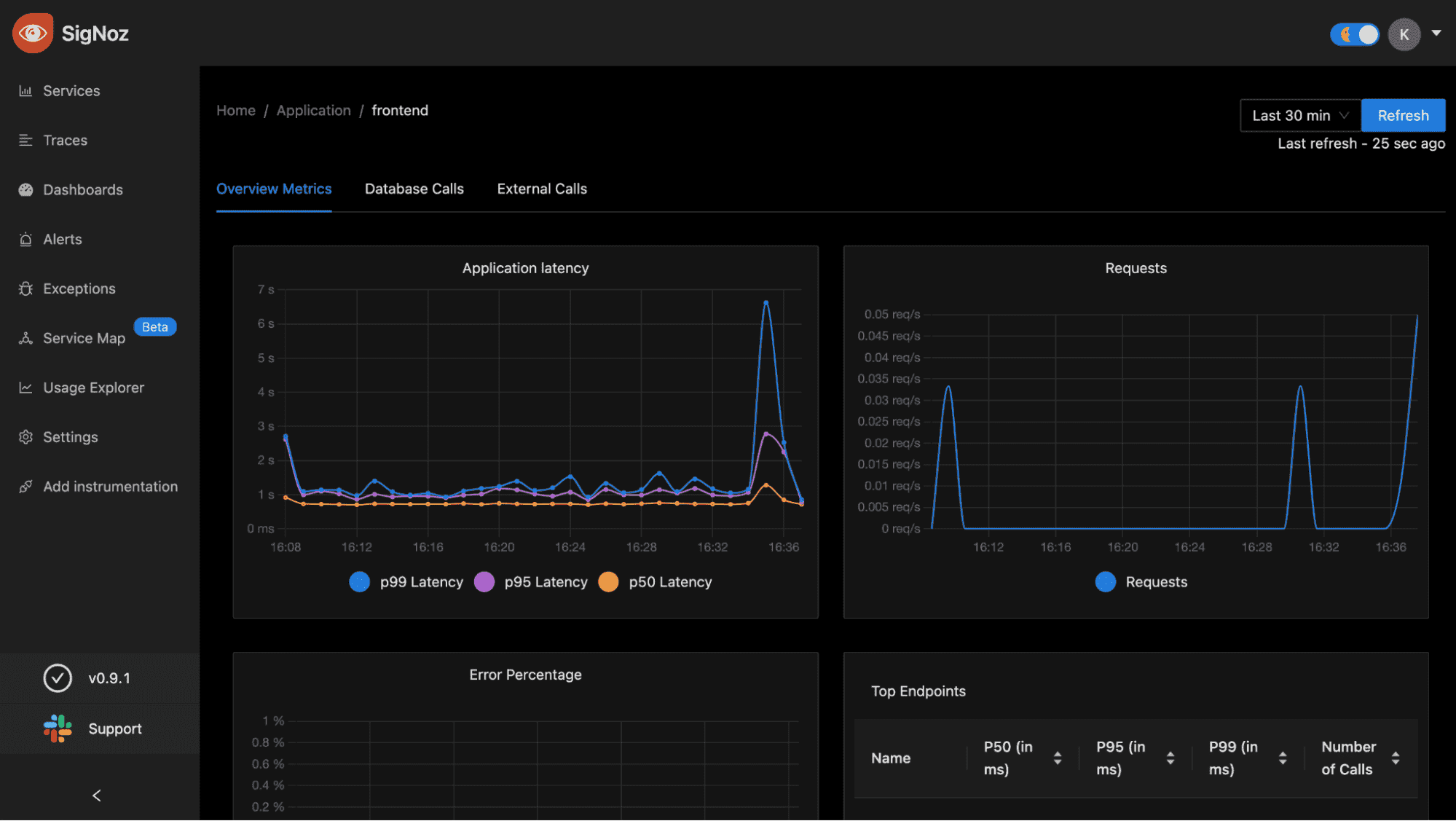
Key strengths:
- Modern, intuitive user interface
- Quick setup and deployment process
- OpenTelemetry-native architecture
- Built-in service dependency mapping
- Active development community
Technical considerations:
- Limited enterprise deployment examples
- Younger ecosystem compared to alternatives
- Some advanced features still in development
- Performance impact needs careful consideration
- Documentation may not cover all scenarios
Cost factors:
- Free open-source solution
- Minimal deployment overhead
- Self-hosted infrastructure costs only
- Community support (enterprise support limited)
Logstash
Logstash is a robust data processing pipeline tool and a core component of the ELK (Elasticsearch, Logstash, Kibana) stack. This open-source solution excels in data collection, transformation, and routing capabilities.
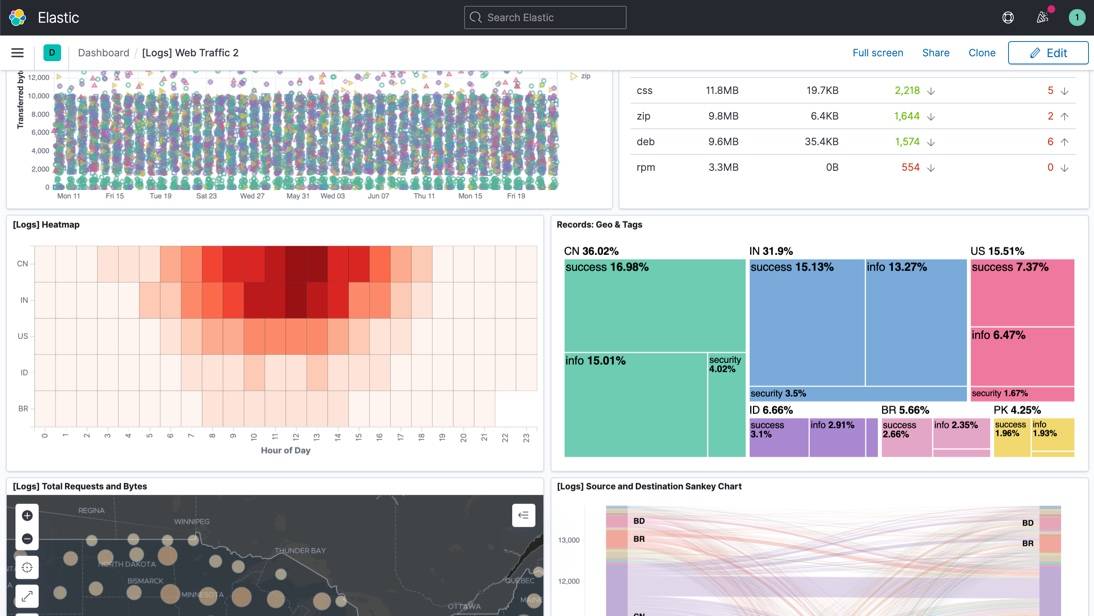
Key strengths:
- Powerful data transformation capabilities
- Extensive plugin ecosystem
- Seamless ELK stack integration
- Flexible pipeline configuration
- Strong community support and resources
Technical considerations:
- Requires significant technical expertise for configuration
- Less user-friendly for non-technical teams
- Real-time processing with some latency compared to Splunk
- Advanced filter configurations
- Multiple input and output plugins
- Custom pipeline development options
Cost factors:
- Free open-source solution
- Part of free ELK stack
- Infrastructure costs for deployment
- Optional paid support from Elastic
- Enterprise features available with subscription
Deploy Logstash independently or as part of the ELK stack using official Docker images for a streamlined setup experience. Perfect for organizations with strong technical teams needing flexible log processing and transformation capabilities.
Fluentd
Fluentd is a lightweight, open-source data collector endorsed by CNCF (Cloud Native Computing Foundation). It specializes in unified logging, focusing on efficient data collection and forwarding.
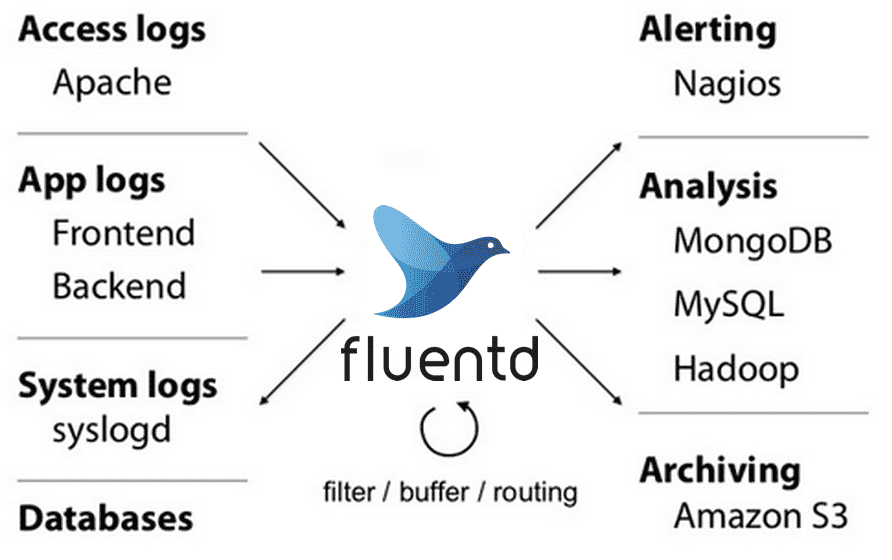
Key strengths:
- CNCF-backed project with strong community
- Lightweight and resource-efficient
- Extensive plugin ecosystem
- Native support for multiple data sources
- Unified logging architecture
Technical considerations:
- Limited to data collection and forwarding
- Not a complete monitoring solution
- Requires additional tools for visualization
- Complex configurations for advanced scenarios
- Memory usage needs careful monitoring
Cost factors:
- Free open-source solution
- Minimal resource requirements
- No licensing costs
- Community support through CNCF
- Optional enterprise support available
Deploy Fluentd as part of your logging pipeline using Docker or package managers. Best suited for organizations needing reliable log collection and transport capabilities within a larger observability stack.
LogDNA
LogDNA is a cloud-based log management platform that focuses on simplifying the collection, analysis, and visualization of log data across diverse sources.
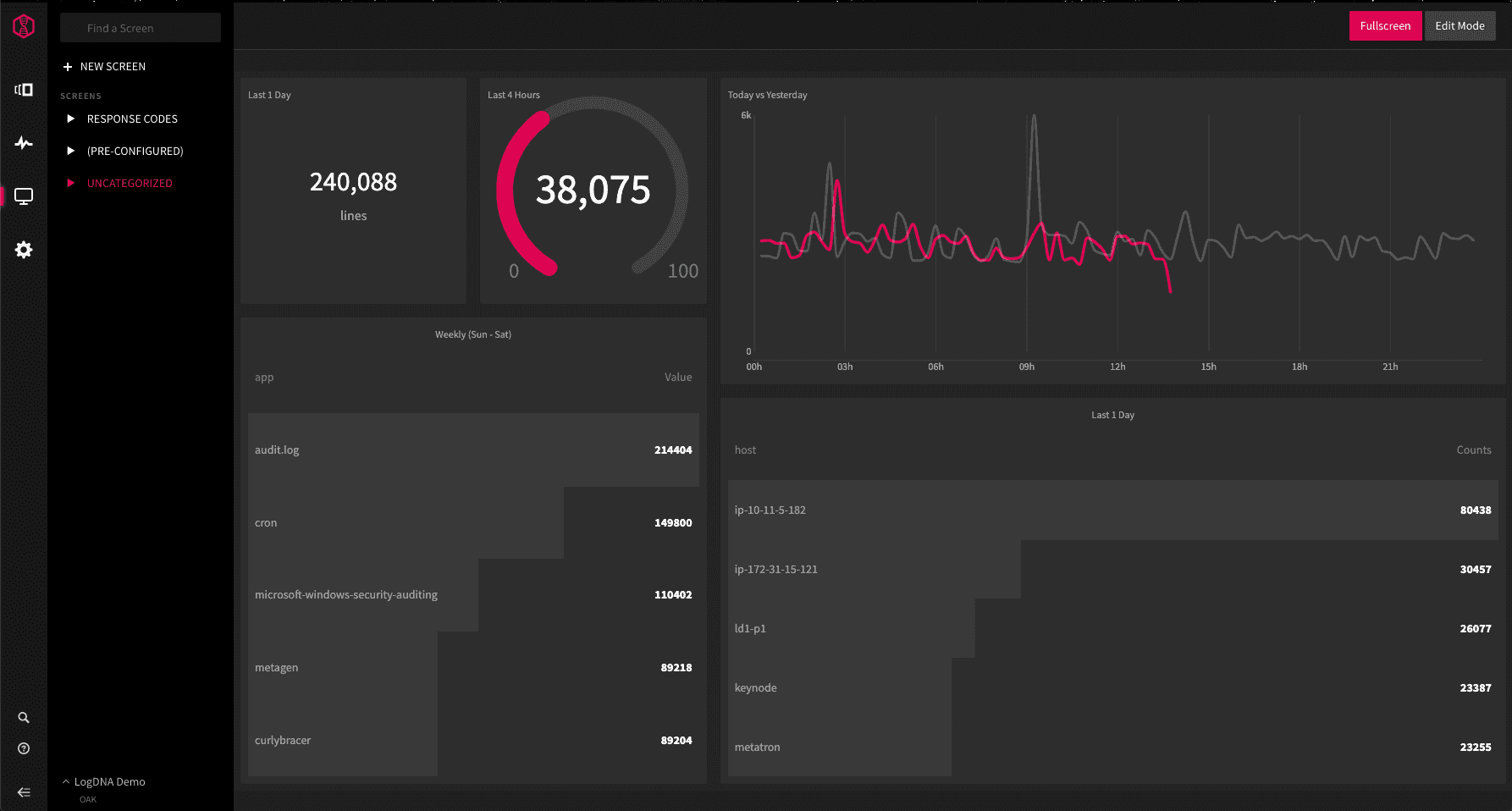
Key strengths:
- Intuitive user interface
- Quick setup and configuration
- Automatic scaling capabilities
- Real-time log streaming
- Multi-cloud support
- Extensive integration options
Technical considerations:
- Limited customization compared to Splunk
- Cloud-only deployment model
- Data retention costs can escalate
- Search capabilities less advanced
- Export limitations in basic tiers
Cost factors:
- Usage-based pricing model
- No free tier available
- Premium support costs extra
- Data volume affects pricing
- Long-term retention fees
Best suited for organizations needing immediate log management capabilities without infrastructure overhead. Offers free trial to evaluate platform capabilities and pricing model impact on your use case.
Logz.io
Logz.io is a cloud-native observability platform that combines log management, monitoring, and security analytics in a unified solution. The platform reimplements the ELK stack as a fully managed service.
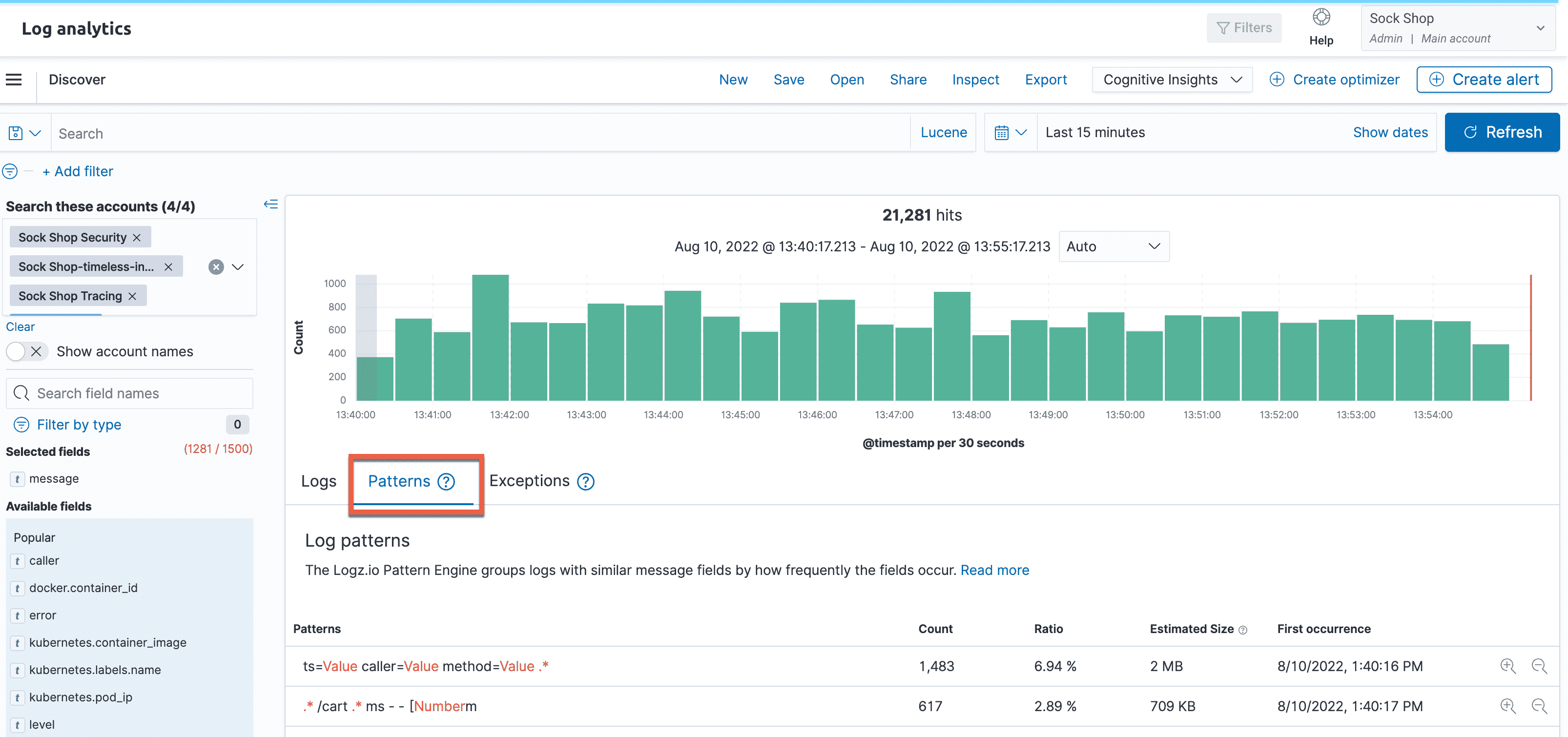
Key strengths:
- Enterprise-grade ELK stack implementation
- Integrated security analytics
- Machine learning capabilities
- Advanced compliance features
- Unified observability approach
- Native Kubernetes monitoring
Technical considerations:
- Cloud-only deployment model
- Vendor lock-in concerns
- Complex pricing structure
- Limited data export options
- Query performance varies with data volume
Cost factors:
- Consumption-based pricing
- Separate charges for different features
- Data retention costs
- Premium support additional
- Regional pricing variations
Ideal for enterprises seeking a managed observability solution with strong security features. Free tier available for evaluation, though enterprise features require paid subscription.
Graylog
Graylog is an open-source log management platform that combines scalability with enterprise features. It stands out through its efficient architecture and integration with Elasticsearch for powerful search capabilities.
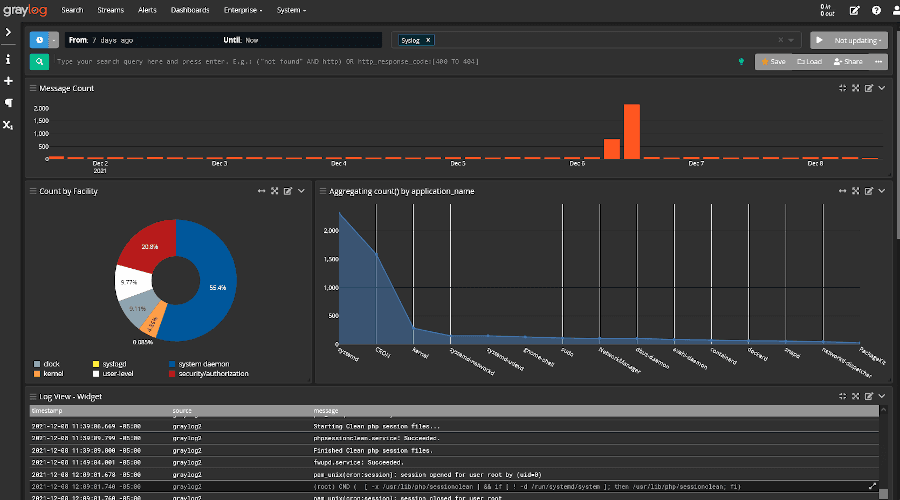
Key strengths:
- Advanced parsing and extraction
- Customizable dashboards
- Powerful search capabilities
- Rich plugin ecosystem
- Horizontal scalability
- Enterprise features in open source
Technical considerations:
- Requires Elasticsearch knowledge
- Complex initial setup
- Resource-intensive for large deployments
- Steep learning curve for advanced features
- Limited visualization options compared to Splunk
Cost factors:
- Free open-source edition
- Enterprise edition available
- Infrastructure costs for self-hosting
- Optional commercial support
- Training costs for team
Well-suited for organizations needing powerful log management with control over their infrastructure. Community edition provides robust functionality, while enterprise edition adds advanced features and support.
Datadog
Datadog is a comprehensive cloud monitoring platform that excels in providing unified visibility across infrastructure, applications, and cloud services. It's recognized as a leader in the observability space.
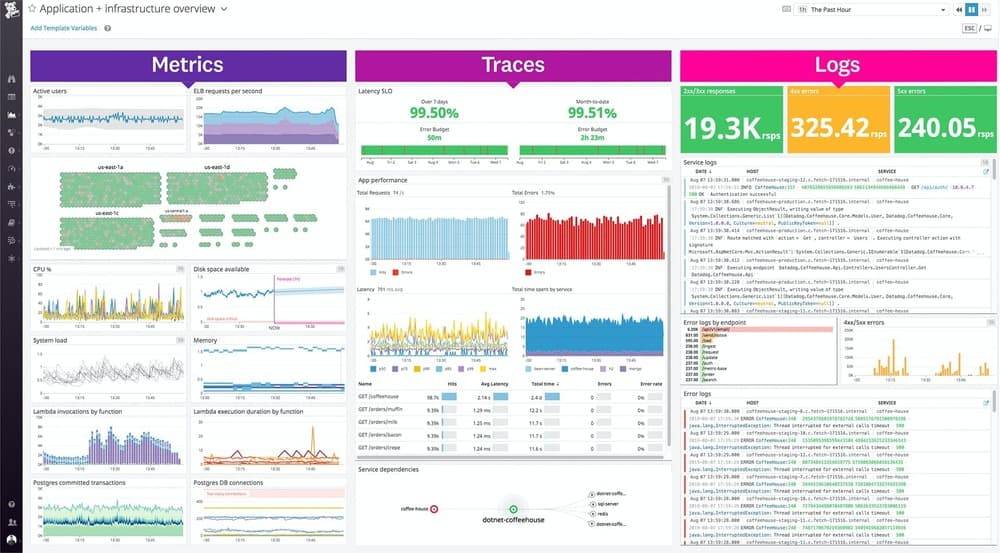
Key strengths:
- Extensive integration ecosystem
- Powerful visualization capabilities
- Advanced analytics and ML features
- Real-time monitoring at scale
- Rich APM functionality
- Unified observability platform
Technical considerations:
- Complex pricing model
- Resource-intensive agent
- High data retention costs
- Feature overwhelm for small teams
- Limited historical data access
- Less flexible than Splunk for custom use cases
Cost factors:
- Premium enterprise pricing
- Per-host/per-service charging
- Separate APM licensing
- Additional costs for features
- High data retention fees
Popular among cloud-native enterprises and organizations with complex infrastructure needs. While powerful, requires careful consideration of costs and feature requirements. Free trial available to evaluate platform capabilities.
New Relic
New Relic is a well-established observability platform focusing on APM and full-stack monitoring. The platform is known for its all-in-one approach to performance monitoring and analytics.
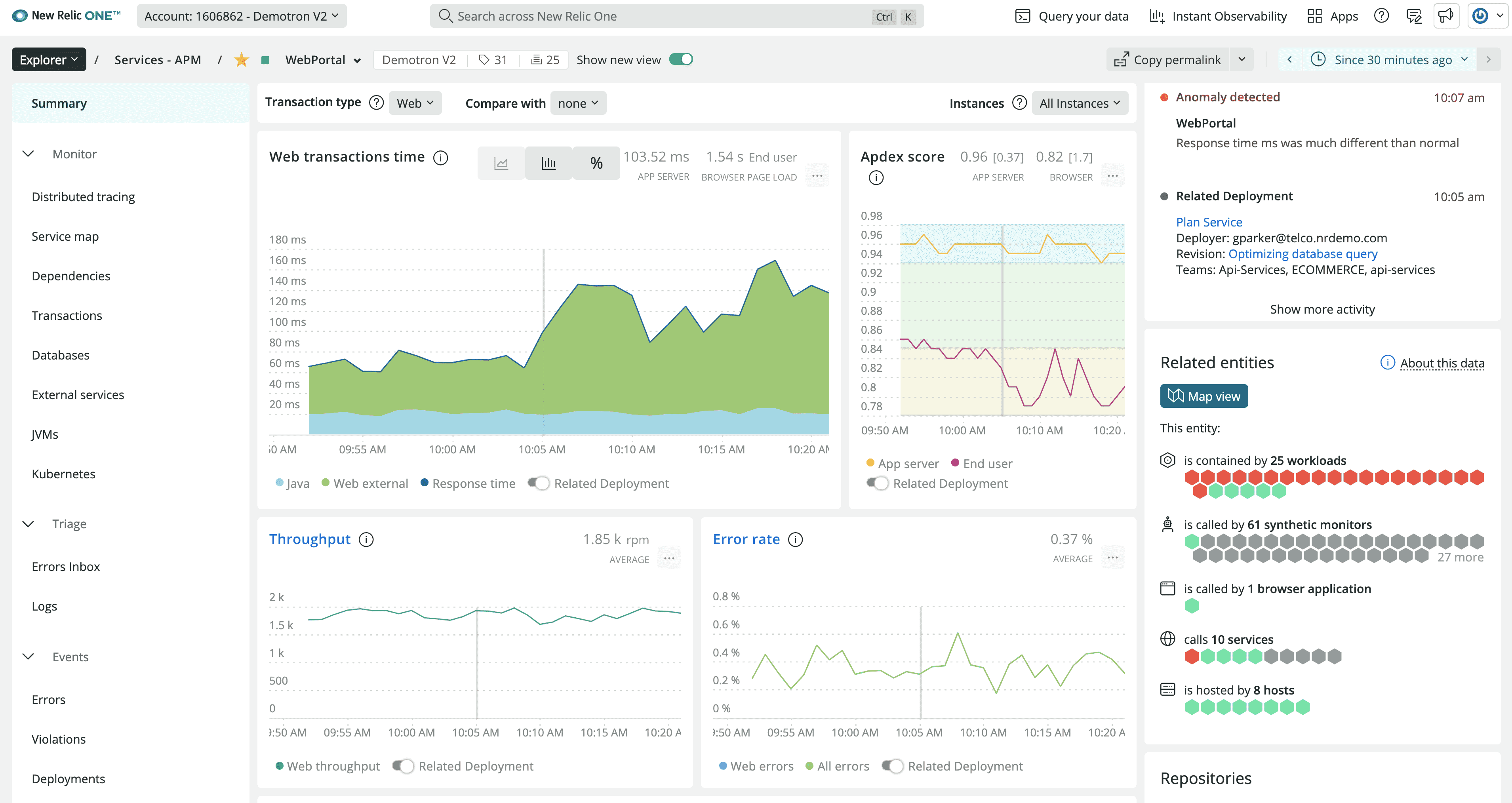
Key strengths:
- Comprehensive APM capabilities
- Full-stack observability
- Rich data visualization
- Extensive DevOps tooling
- AI-powered analytics
- Strong mobile app monitoring
Technical considerations:
- Agent deployment overhead
- Complex pricing structure
- Data sampling in high-volume scenarios
- Learning curve for advanced features
- Resource-intensive implementation
- Some features require enterprise tier
Cost factors:
- Consumption-based pricing
- Data ingest fees
- Feature-based licensing
- Premium support costs
- Training and implementation expenses
Popular choice for organizations requiring deep application performance insights. Recent pricing model changes offer more flexibility but require careful capacity planning. Free tier available for evaluation and small-scale deployments.
Dynatrace
Dynatrace is an enterprise-grade APM and observability platform powered by AI capabilities. The platform distinguishes itself through automated discovery and deep application insights.
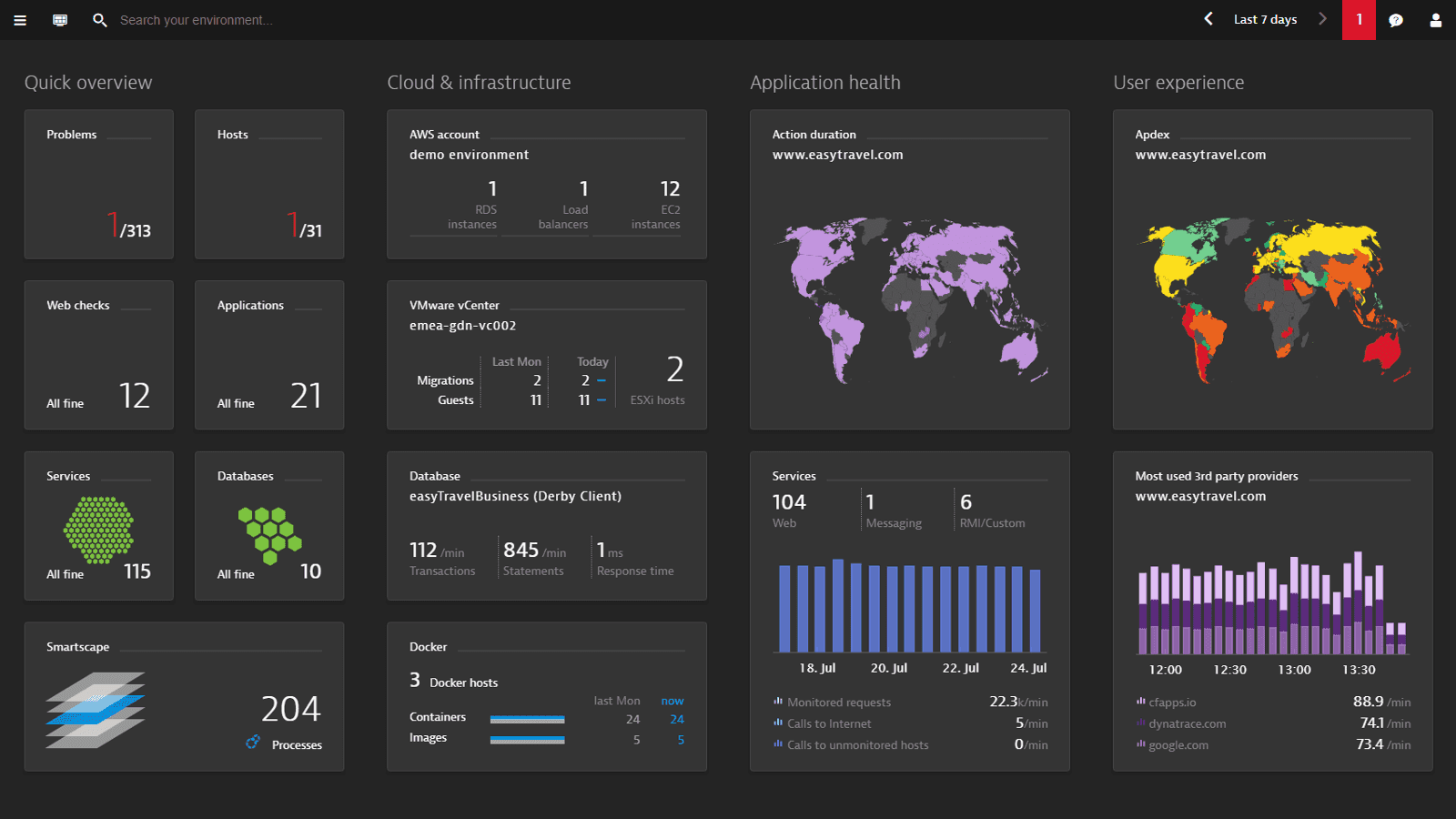
Key strengths:
- AI-driven root cause analysis
- Automated service discovery
- Advanced user experience monitoring
- Full-stack observability
- Precise dependency mapping
- Enterprise-grade security
Technical considerations:
- High resource requirements
- Complex initial configuration
- Significant learning investment
- Limited customization options
- Rigid deployment model
- Heavyweight agent footprint
Cost factors:
- Premium enterprise pricing
- Host-based licensing model
- Module-based pricing
- Long-term commitments
- Additional costs for features
- Professional services often needed
Particularly strong for large enterprises with complex application landscapes. While offering powerful automation and insights, requires substantial investment in both costs and expertise. Free trial available but limited in scope.
AppDynamics
AppDynamics, now part of Cisco, is an enterprise APM platform that specializes in business transaction monitoring and application performance insights.
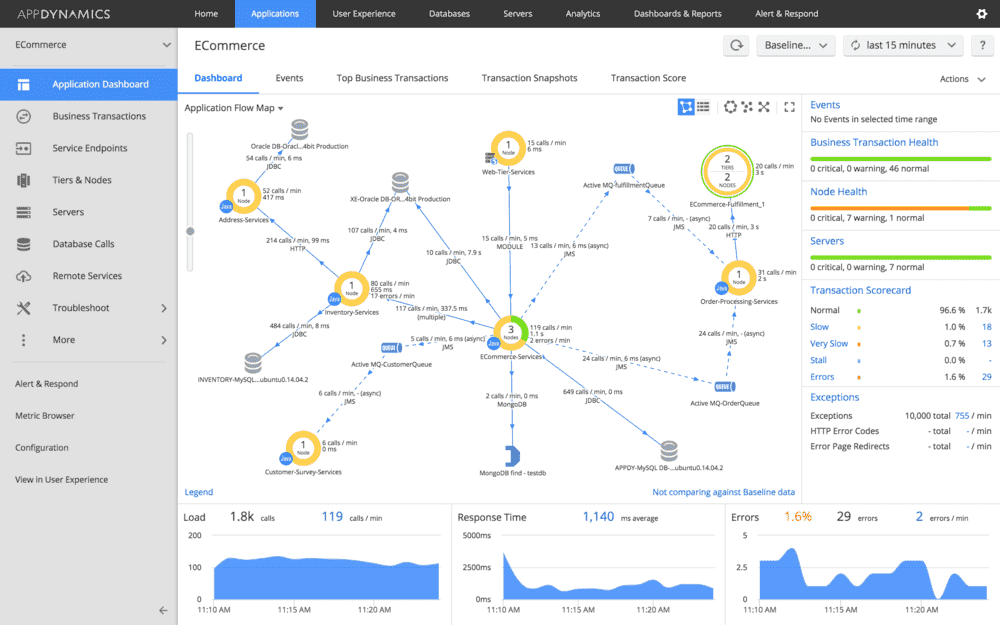
Key strengths:
- Deep transaction monitoring
- Business-centric monitoring
- Advanced correlation capabilities
- Cisco ecosystem integration
- Robust baseline automation
- Strong enterprise support
Technical considerations:
- Significant setup complexity
- Heavy agent overhead
- Limited data retention
- Complex licensing model
- Steep learning curve
- Resource-intensive deployment
Cost factors:
- Premium enterprise pricing
- Per-unit licensing
- Professional services required
- Additional module costs
- Enterprise support fees
- Long-term contract focus
Preferred by large enterprises needing detailed transaction monitoring and business insights. While powerful, requires substantial investment in both implementation and licensing. Proof of concept recommended before commitment.
Loggly
Loggly, now part of SolarWinds, is a SaaS-based log management solution focusing on simplicity and cloud-native log analysis.
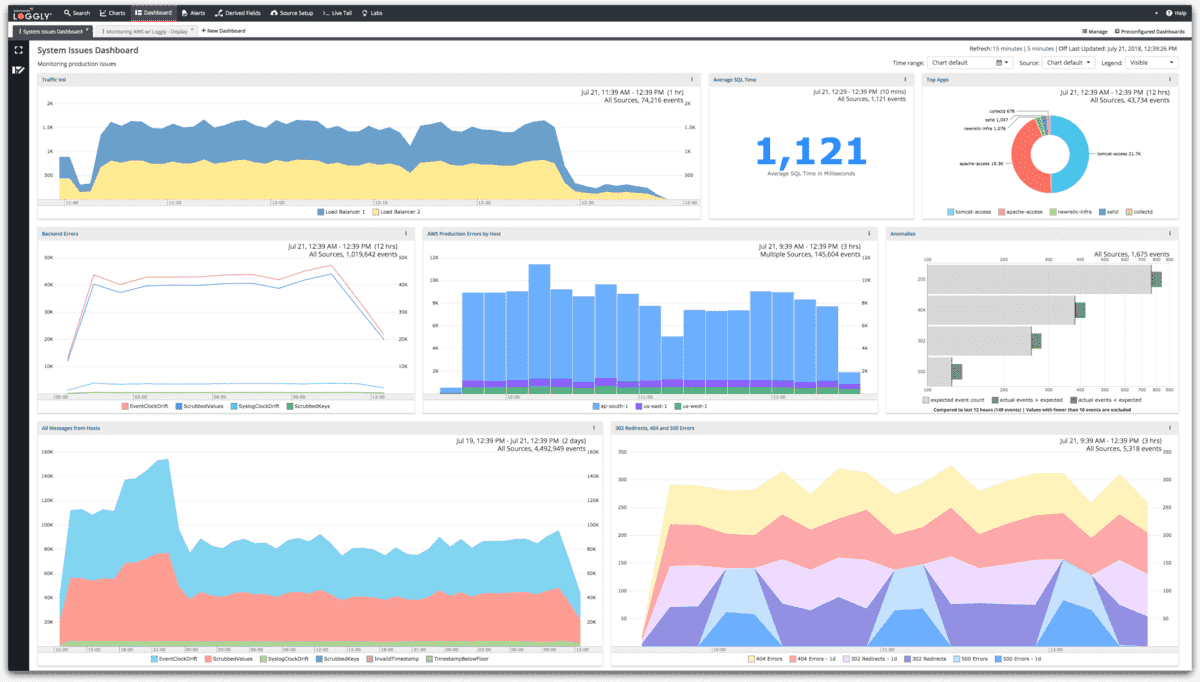
Key strengths:
- Quick setup and configuration
- Intuitive search interface
- Automated parsing
- Pre-built dashboards
- Multi-account management
- Basic anomaly detection
Technical considerations:
- Limited advanced analytics
- Restricted customization options
- Search performance varies
- Basic alerting capabilities
- Data ingestion delays
- No on-premise option
Cost factors:
- Volume-based pricing
- Retention period impacts cost
- Standard vs Enterprise tiers
- Add-on feature costs
- Support tier pricing
- No free tier available
Best suited for small to medium organizations needing straightforward log management without infrastructure overhead. Offers simpler functionality than Splunk but easier adoption curve. Trial available to assess platform limitations.
Conclusion
Selecting the right observability tool depends on your organization's unique needs, infrastructure, team expertise, and budget. Below is a breakdown of the best use cases for each tool, helping you make an informed decision:
Uptrace
- Best For: Teams seeking a scalable, open-source observability solution with advanced APM features and real-time insights.
- Why Choose Uptrace: It offers flexible deployment, a strong integration ecosystem, and an active community, making it an excellent choice for organizations prioritizing observability without high costs.
Skywalking
- Best For: Microservices and cloud-native architectures, particularly those requiring distributed tracing and service mesh monitoring.
- Why Choose Skywalking: It excels in tracing and AI-powered analysis, but it requires a more technical team to deploy and manage effectively. Ideal for those with strong technical resources.
SigNoz
- Best For: Teams needing a user-friendly, intuitive APM tool with quick deployment and deep insights.
- Why Choose SigNoz: Its modern interface and OpenTelemetry-native architecture make it easy to use. However, as a newer tool, it may not yet have the maturity of other options.
Logstash and Fluentd
- Best For: Managing large volumes of log data and routing it through flexible pipelines.
- Why Choose Logstash: Offers powerful data transformation and integrates seamlessly with the ELK stack.
- Why Choose Fluentd: Lightweight and efficient, making it ideal for simpler setups with minimal resource requirements.
LogDNA
- Best For: Cloud-native log management with minimal setup.
- Why Choose LogDNA: It’s great for quick log streaming and multi-cloud support, but lacks the deep customization and advanced features of more complex tools.
Logz.io
- Best For: Enterprises looking for a managed service with integrated security analytics and machine learning.
- Why Choose Logz.io: Combines advanced log management with security features, though the cost model can escalate quickly for large environments.
Graylog
- Best For: Teams needing robust log management with powerful search capabilities and scalability.
- Why Choose Graylog: Offers fine-grained control over log data processing but requires a complex setup and resources for large deployments.
Datadog, New Relic, and Dynatrace
- Best For: Large enterprises with complex infrastructures needing full-stack observability and advanced analytics.
- Why Choose These Tools: These enterprise-grade solutions provide robust monitoring but come with steep learning curves, high pricing models, and potential feature overwhelm.
AppDynamics
- Best For: Large enterprises needing business-centric transaction monitoring and business performance insights.
- Why Choose AppDynamics: It excels in providing detailed visibility into business processes, but requires significant investment in resources and costs.
Loggly
- Best For: Smaller teams or those with simpler log management needs.
- Why Choose Loggly: Its intuitive, cloud-native interface makes it easy to use, but it lacks the advanced features and customization of more enterprise-focused tools like Splunk or Datadog.
Final Thoughts
When making your decision, consider testing free trials or demos offered by these solutions to evaluate whether the tool meets your specific needs. Here’s a recap:
- Uptrace for cost-effective, open-source observability.
- Skywalking for microservices and cloud-native architectures.
- Datadog, New Relic, or Dynatrace for full-stack, enterprise-grade solutions.
- Logstash, Fluentd, and LogDNA for log management with varying levels of complexity and resource requirements.
FAQ
- How does pricing compare between Splunk and its alternatives? Pricing for Splunk can be significantly higher compared to other log management solutions. While Splunk is known for its robust features, alternative providers like Elastic Stack or Graylog often offer more affordable pricing, especially for smaller teams. However, Splunk offers a comprehensive enterprise-level solution with advanced analytics, which may justify the cost for larger organizations with complex needs.
- What’s the typical migration timeframe from Splunk to another tool? Migration time depends on the scale and complexity of your current infrastructure. A straightforward migration to alternatives like Elastic Stack or Loki might take anywhere from a few days to a couple of weeks. For larger setups, especially those relying on Splunk’s proprietary features, the process may take a few months to ensure seamless data transfer, reconfiguration, and testing.
- Which tool offers the best performance-to-cost ratio compared to Splunk? Solutions like Graylog, Elastic Stack, and Fluentd often offer a better performance-to-cost ratio compared to Splunk, particularly for organizations with limited budgets. While Splunk excels in its features and support, tools like Elastic Stack deliver competitive performance at a fraction of the cost, making them a popular choice for companies focused on cost-efficiency.
- How do support services compare between Splunk and other log management providers? Splunk provides extensive support through various tiers, but this comes at a premium price. For smaller businesses or those with limited support needs, alternatives like Logz.io or Graylog offer solid basic support and community-driven help, while providing additional paid support options if necessary. However, enterprise tools like Splunk offer more comprehensive support with specialized assistance for large-scale environments.
- Can I use Splunk alongside other logging tools? Yes, many organizations use Splunk alongside other log management or monitoring tools like Prometheus or Datadog to cover different aspects of their infrastructure. While Splunk excels in log analysis, other tools might handle specific use cases, such as metrics monitoring or application performance monitoring. Integrating multiple tools requires careful configuration to ensure smooth data flow and prevent redundancy.
- What about data transfer costs when moving data between Splunk and other providers? Data transfer costs when moving logs from Splunk to another tool can add up. Splunk charges for data indexing, and exporting large datasets to other platforms may incur additional fees. Alternatives like Elastic Stack tend to have more predictable and affordable data transfer pricing, making them a preferred choice for businesses looking to minimize costs when handling large volumes of log data. Always consider transfer fees, especially when scaling your log management infrastructure.
You may also be interested in: